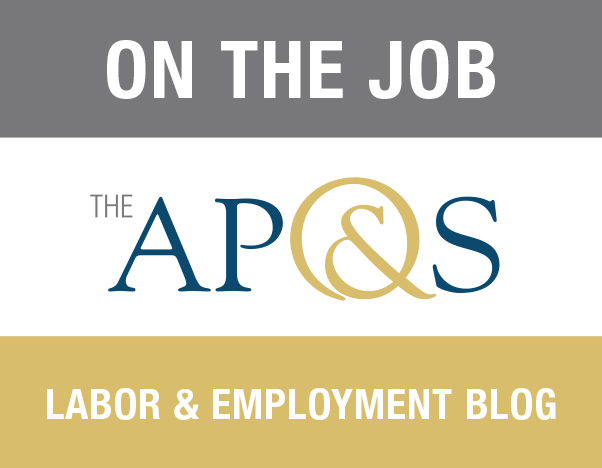Recently, businesses have been inundated with information regarding the novel coronavirus (COVID-19) that emerged in China in 2019. Since then, there have been reports of cases throughout the world, including presumptive and confirmed cases in twenty (20) U.S. states. With the broadening spread of this illness, there are a number of critical steps businesses can take to protect the health and welfare of its employees. However, implementing the recommendations and guidelines suggested by local and state health department authorities, along with the Centers for Disease Control (CDC), can present legal challenges, and it is difficult to know where to begin. We at Adler Pollock & Sheehan are here to help your business navigate this situation as it evolves and changes.
Every business is different, so if you have specific questions about how to implement the recommendations below, or if you need help updating your policies, please contact us and we will be happy to assist. While there have been news items about an impending pandemic, it is important for you to remain calm and prepare your business for what may be coming. Remember – a good offense is an effective defense.
Next, review the CDC’s guidance – Interim Guidance for Businesses and Employers to Plan and Respond to Coronavirus Disease 2019 (COVID-19), February 2020. Keep this link handy, as the CDC updates its guidance as new information is gathered. You also will want to check the local and state health department authorities in each jurisdiction in which you have an office. In Rhode Island, the Department of Health (RIDOH) has a dedicated webpage, found here, and a telephone line dedicated to answering general questions about COVID-19 (401-222-8022) (please note, this line is only answered from 8:30 – 4:30 on weekdays). If you prefer email, you can reach out to the RIDOH at RIDOH.COVID19Questions@health.ri.gov.
We have highlighted some of the recommendations below, including what to consider as you formulate an Emergency Plan (“Plan”) in the event that COVID-19 becomes widespread in your community.
Finally, if you have questions about legal issues or need assistance formulating your business’s unique response plan, please reach out to us; we are here to help you navigate the issues raised by COVID-19.
A Good Offense is a Good Defense: Strategies to Prevent Illness in the Workplace
.
Know What You’re Looking For
It is impossible to prevent illness transmission if you don’t know what the illness looks like. COVID-19 is an acute respiratory illness, and presents with symptoms including a fever, cough, and shortness of breath. A person may begin to exhibit symptoms anywhere between 2 days to 2 weeks after they were infected with the COVID-19 virus.
There’s No Place Like Home.
Your employees will need reminding that when they are sick, they must stay home. Having employees out sick decreases productivity, but having them come to work and spread the illness to other employees is worse. It is critical that you make sure your employees know to stay home if they exhibit symptoms associated with an acute respiratory illness.
Before an employee returns to work following an illness, make sure they meet the CDC criteria for doing so: symptom and fever free for at least 24 hours, without the use of medications (such as a cough suppressant).[1]
Also, take a look at your company’s sick leave policy. Does it allow for flexibility? Does it permit employees to stay home if they are caring for an ailing family member? The CDC has emphasized the likelihood that employees may need to stay home if someone in their household is sick, which is important to the employee, but also so that the employee does not spread the illness of the family member in the workplace. Allowing employees to work remotely and providing further flexibility will help your employees to feel comfortable with their decision to stay home. If you would like specific tips on how you may adapt your sick leave policy to this ever-evolving situation, we can help.
A Sick Employee Has Shown Up For Work
Despite your best efforts to emphasize your flexible and comprehensive sick leave policy, one of your dedicated employees has come into work with a fever and cough. What do you do now?
Immediately separate the ailing employee from the rest of your staff and SEND THE EMPLOYEE HOME! The law allows employers to remove an employee showing symptoms of influenza from the workplace and send that employee home.
Be Sure To Let Your Employees Know That You Mean BUSINESS!
It is important to let your employees know that you take the risk of the spread of COVID-19 seriously. Hang posters throughout your office in common areas (kitchens, bathrooms, near printers and copiers, elevators, and vending machines) to remind your employees to:
- Stay away when sick;
- Cough and sneeze into a tissue (or an elbow if a tissue is not available);
- To wash hands early and often with soap and water for at least 20 seconds, particularly after using the restroom or any other exposure to bodily fluids.
- Make appropriate hygiene easy to adhere to by placing no-touch tissue dispensers and no-touch disposal receptacles in convenient places throughout the office.
- Provide access to alcohol-based hand sanitizer (60-95% alcohol) at such receptacles, in case handwashing is not immediately possible.
KEEP THE WORKPLACE CLEAN!
Be sure that every frequently touched surface in your workplace – such as door knobs and door handles, common appliances, countertops, light switches, computers, and common workspaces are cleaned often.
Make this step easier by supplying disposable disinfecting wipes to your employees so they may clean their work station and the common areas they use.
Limit Unnecessary Travel
Many international companies have stopped non-essential international travel in an effort to protect their employees and depending on the business, it may be easier to simply eliminate all nonessential business travel. Employers may also need to address vacation travel among their workforce. Employees who travel to those places that the CDC has determined propose a high risk of COVID-19 transmission may need to be asked to self-quarantine for fourteen (14) day upon their return.
Whether traveling for work or pleasure, make sure your employees check the CDC’s Traveler’s Health Notices (available here). This provides guidance and recommendations based on the country to which you are traveling. The CDC has implemented Level 3 travel notices – which advise against non-essential travel – to Italy, Iran, South Korea, and China. A Level 2 Alert relating to COVID-19 is in effect for travel to Japan, which means those traveling should practice enhanced precautions.
Make sure your employees are monitoring themselves for symptoms of acute respiratory illness before, during, and after travel. If they exhibit any such symptoms, make sure they notify their supervisor and stay home until they are well. If your employees are traveling and they get sick, make sure they notify their supervisor and seek medical advice if necessary.
Ultimately, you cannot require your employees to cancel travel plans. However, you can advise them of their options, and make sure they make informed decisions when deciding to travel.
Assess The Risk
It is important that you and your employees understand that this is a team effort and you cannot protect their health and safety without their assistance.
Underscoring the importance of this teamwork includes conducting a risk assessment should an employee or their family member contract COVID-19. The CDC has issued this helpful guide that defines the various risk levels. If an employee or their family member does get COVID-19, make sure they follow these simple steps:
- Be sure the employee immediately notifies their supervisor of the situation – including who is sick, for how long, and any other pertinent details.
- If one of your employee’s family members is sick, conduct a risk assessment and consider whether it is best if your employee stays home to care for that family member. With an incubation period of up to 14 days, it is possible your employee could be home for more than two weeks.
- In the event that an employee has COVID-19, you should alert your employees that they may have been exposed to COVID-19 in the workplace. It is paramount, however, to protect the privacy of your ailing employee.
Education is Key
Strains of coronaviruses like COVID-19 do not affect everyone equally. Make sure your employees know if they are at an increased risk of developing a more severe illness. Those at this increased risk include older adults, persons with chronic medical conditions (including asthma, COPD, and other respiratory-related issues), and persons with compromised immune systems.
If you need additional assistance in reviewing the steps your company should take with regard to how COVID-19 impacts your employees, you may contact Robert Brooks at rbrooks@apslaw.com or Michael Chittick at mchittick@apslaw.com, of the Labor and Employment Law Department at Adler Pollock & Sheehan.
[1] An adult has a fever if, using an oral thermometer, their temperature is 100.4 (37.8 C) or higher.






